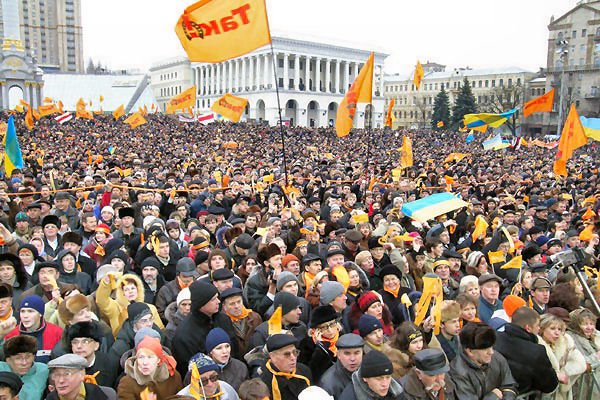BY SUSANNAH VILA
THE CHALLENGE
The 2004 presidential elections in Ukraine were marred by election fraud and voter intimidation. How could Ukrainian citizens express their outrage and pressure the state to hold new, legitimate elections? Would they be able to, despite the bitter cold of winter, organize enough demonstrators to successfully pressure the government into accepting citizens’ demands?

THE PLAYERS
Nonpartisan exit polls during the presidential runoff election beween Prime Minister Viktor Yanukovich and opposition candidate Viktor Yushchenko gave the latter a strong lead. Yet when the official results were released, Yanukovich had apparently beaten the opposition by 2.5 percent.
Ukrainian citizens quickly realized these results were fraudulent. Independent, nonpartisan election-monitoring organizations confirmed their suspicions. Making matters worse, the mainstream media appeared unable to transparently report on the election fraud.
Yushchenko called for citizens to join him at Maidan, Kyiv’s Independence Square, to express their outrage.
The coordination of demonstrations was initiated by a pro-democracy group known as Pora. Pora had been monitoring the elections and using the internet as a platform for generating awareness.
THE TOOLS AND TACTICS
In November 2004, Ukraine had an estimated 6 million distinct internet users out of a population of 48 million. Despite this relatively low internet penetration rate, members of Pora and Maidan, another pro-democracy group, initially convened online to share information and ideas.
They then moved actions from the web to text messaging to communicate with more people. Alternative media also aided in the sharing of information, as the government didn’t shut it down at any point.
Pora, already experienced in organizing demonstrations, quickly sprung into action. More and more Ukrainians began sending text messages to friends, encouraging them to come out and protest. The demonstrations, which became known as the Orange Revolution, were carried out over a week and a half.
The use of SMS was critical to maintaining momentum and planning logistics. Participants did not converge on the central square of Kiev at the same time; instead, text messages were used to coordinate shifts. Pora had brought out nearly 1,500 tents, which were scattered around the outskirts of the main square for participants to sleep in. This resulted in the leveling of a constant pressure on Parliament.
THE STUMBLING BLOCKS
The absence of campaign-altering obstacles in these events can be attributed to the strong planning and organization of the pro-democracy groups that spurred the protests.
A large mass of people swarming on the city’s main square could have turned violent and gotten out of hand, but the members of Pora and other groups were committed to nonviolent protest and worked with the crowds to make sure they stayed calm and orderly.
The organizers also made sure to work with security forces to prevent any outbreaks of violence on either side. As the USIP reports:
“The organizers also made concerted efforts to dissuade the security forces from resorting to violence. Intense coverage by independent media ensured that any violence against the protestors would be broadcast worldwide, giving credibility to the claim that individuals within the security forces would be held responsible for any bloodshed.
“The organizers sent clear messages of their nonviolent intent to the security forces, according to the experts. In Ukraine in particular, networks were established between military and opposition leaders, and private connections and assurances were made.”
The role of already existing, durable organizations in sustaining the campaign cannot be overstated; without Pora and Maidan, the demonstrations may have died down much earlier.
THE OUTCOME
As the movement gained strength, Ukrainian military and security forces began to dissipate. This helped maintain peace in Kiev and other cities where demonstrations were held. Segments of Ukraine’s official Security Service chose to cooperate with the Yushchenko camp and not use force on the protesters.
The demonstrations—carried out over 17 days—ultimately resulted in new, legitimate elections being held that brought Yushchenko to power.
Similar to People Power II in the Philippines, the events of the Orange Revolution (named after the orange-colored shirts protesters wore to express their solidarity) underscore the impact of technology on democracy, but only if citizens are upset enough to withstand bitter cold temperatures while protesting, capable of using technology more effectively than the government, and activists lay out strong groundwork for protests. Movements.org






